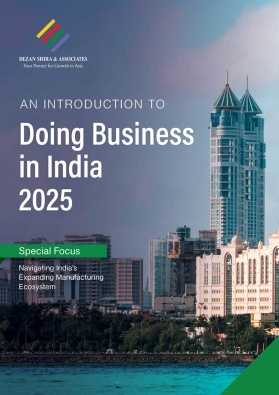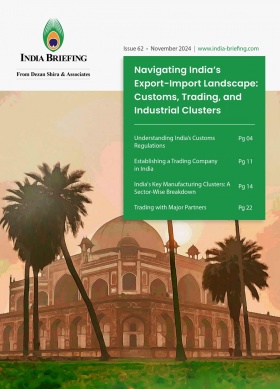Why You Should Consider Investing in India’s Odisha State
Well-connected to key trade and manufacturing hubs in South and Southeast Asia, Odisha is home to the Paradip port, the largest port in eastern India. In this state profile, we explore the major sectors in Odisha and the investor facilitation policies that support business growth.
The state of Odisha is situated in the eastern part of India with a coastline of around 500km. It is bounded by the Bay of Bengal on the east, Chhattisgarh state on the west, and Andhra Pradesh state to the south. The state enjoys 33 percent forest cover and abundant ecotourism, agriculture, and industrial opportunities.
Odisha’s strategic location on the eastern coast provides a natural gateway to South Asia and ASEAN economies. With three major ports—Paradeep, Dhamra, and Gopalpur—along its 450 km coastline, Odisha is well connected to international markets, with a combined cargo handling capacity of 170 MTPA. The government is developing industrial cities equipped with plug-and-play facilities and working to connect ports to industrial clusters to reduce logistics costs.
Odisha investor summit 2025
The Utkarsh Odisha-Make in Odisha Conclave 2025, held in Bhubaneswar, achieved a remarkable milestone by securing INR 16.73 trillion in investment intentions, far exceeding its initial target of INR 5 trillion. The event attracted 595 proposals across 20 sectors, with Chief Minister Mohan Charan Majhi expressing pride in the overwhelming global and domestic investor interest. During the summit, 145 investment-related MoUs were signed.
The proposed investments span diverse sectors, including chemicals, petrochemicals, textiles, mining, metallurgy, renewable energy, IT/ITeS, tourism, and food processing. International partners from Singapore, Malaysia, and Australia joined the government to explore collaborative growth opportunities.
Key announcements included:
- The Adani Group pledged INR 2.3 trillion in investments over five years, focusing on power, cement, industrial parks, aluminum, city gas, and port expansion.
- The Avaada Group committed INR 207 billion for renewable energy projects, including floating solar, pumped storage, and green energy equipment manufacturing in Odisha.
- Jindal Steel & Power and Birla Group announced plans to invest an additional INR 700 billion and INR 500 billion, respectively, in the state’s growth.
Ease of doing business: Investor facilitation in Odisha
The Government of Odisha has launched the GO SWIFT portal (Government of Odisha – Single Window for Investor Facilitation and Tracking) to streamline the business-to-government (B2G) interface throughout the entire investment lifecycle. Further, Odisha’s Industrial Policy Resolution (IPR) 2022 offers a wide range of monetary incentives for investments in various sectors.
GO SWIFT was mandated by the Odisha Industries (Facilitation) Act 2004, with the goal of simplifying the process for obtaining approvals and clearances for industrial projects. To implement this, an online Combined Application Form (CAF) was introduced, which all relevant departments and authorities are obligated to accept and handle.
GO SWIFT aims to provide investors with easy access to all necessary information and clearances in a hassle-free, paperless manner. The portal serves as a comprehensive “One-stop Solution” for obtaining information on required clearances, available land banks, G2B service applications, payments, tracking and approvals, synchronized risk-based inspections by regulatory agencies, incentive management, post-land allotment services, grievance resolution, and aligning CSR activities with the state’s development goals.
The Odisha government has also created Investment Facilitation Cells at both the state and district levels as part of its efforts to improve the investment climate and support industrial development. These cells, operating under Industrial Promotion and Investment Corporation of Odisha (IPICOL) at the state level and District Industries Centers (DICs) at the district level, aim to facilitate land allotment and approvals, ensuring timely processing of applications, conducting awareness programs for investors, and following up on approvals within specified timelines.
Industrial policy
The Odisha Industrial Policy Resolution 2022 is a key policy initiative aimed at positioning the state as a leading industrial center in Eastern India. The IPR outlines the state government’s vision for industrial transformation and highlights thrust sectors in Odisha that will receive focused attention and incentives, both fiscal and non-fiscal, to spur growth and development.
|
Odisha Industrial Policy Resolution 2022: General provisions |
|
|
Employment generation subsidy |
100 percent reimbursement in new industrial units in Priority and Thrust Sectors for a period of 5-7 years. |
|
Stamp duty exemption |
100 percent Exemption |
|
Electric duty exemption |
100 percent Exemptions for 7-10 years in priority and thrust sector |
|
State goods and services tax (SGST) reimbursement |
100 percent reimbursement, limited to 200 percent of the cost of plant and machinery for priority and thrust sector |
|
Investment subsidy |
20 percent (Priority Sector) or 30 percent (Thrust Sector) capital investment subsidy, disbursed over 5 years |
|
Land incentive |
Allocation of land in industrial areas at concessional industrial rates by IDCO. 100 percent exemption from payment of premium on land registration. New industrial units in Thrust Sectors, generating over 1000 jobs for state residents, qualify for land at 50 percent of the industrial rate (excluding BDA and CDA). |
Economic profile of Odisha
In 2023-24, the sector-wise contribution to Odisha’s economy (Gross State Value Added at current prices) was estimated to be 21 percent for the agriculture and allied sector, 43 percent for the industrial sector, and 36 percent for the services sector.
Gross State Domestic Product (GSDP) growth rate for Odisha was estimated to be 8.5 percent in 2023-24 at constant prices.
In terms of attracting industrial investments, the focus sectors for Odisha state are tourism and hospitality, food and seafood processing, chemicals and petrochemicals, electronic system design and manufacturing (ESDM), ancillary and downstream industries in the metal sector, and textiles.
Key sectors for investment in Odisha
Mineral sector
Odisha possesses significant mineral reserves, including 28 percent of India’s iron ore, 24 percent of its coal, 59 percent of bauxite, and 98 percent of chromite deposits. This abundance of resources has drawn the interest of numerous mining and metallurgical firms.
In 2023, the state government introduced the Long Term Linkage (LTL) policy. The policy offers long-term ore linkages for iron ore, chromite, bauxite, and limestone produced by the Odisha Mineral Corporation (OMC). This linkage will be available to investors establishing end-use plants, with provisions for greenfield or expansion projects, regardless of whether they have mechanized evacuation systems.
Several conglomerate firms have made investments in Odisha’s metal and minerals sector, including the JSW Group, led by Sajjan Jindal, the Kalyani group, ArcelorMittal Nippon Steel (AMNS), etc.
- The JSW Group has plans to establish an integrated steel manufacturing complex in Paradip, a key coastal town housing one of India’s major ports, with an estimated investment of INR 650 billion. The complex will feature a steel plant with a 13.2 MTPA capacity, alongside a cement factory, a captive power unit, and a cargo handling facility.
- ArcelorMittal Nippon Steel India (AM/NS India) has signed a memorandum of understanding (MoU) with the Odisha state government to develop a 24 MTPA greenfield mega steel plant in Kendrapara district, with an investment of INR 1.02 trillion. Though this project will have a long gestation period, AM/NS India already operates in Odisha, with facilities including an iron ore mine, a slurry pipeline, and a pellet plant in Paradip.
- Kalyani Steel Limited has outlined plans for a significant investment of INR 260 billion to establish a manufacturing facility for titanium metal and aerospace components, along with an integrated complex for advanced specialty steel and automotive components in Gajamara, located in Odisha’s Dhenkanal district, according to a report by The Economic Times.
Ancillary and downstream industries in the metal sector
Odisha contributes to 20 percent of India’s steelmaking capacity and 54 percent of its aluminum smelting capacity. The state’s rich mineral resources have attracted significant investments in the downstream and ancillary metal sectors. Odisha’s aluminum downstream industry, which processes products like sheets, extrusions, foils, and castings, is particularly strong, serving sectors such as transportation, packaging, construction, and electrical.
Odisha has actively promoted investment regions and industrial parks, including the Kalinganagar National Investment and Manufacturing Zone, the Downstream Aluminum Park at Angul, and the Downstream Steel Park at Angul. These parks are supported by major metal manufacturers like Tata Steel, JSL, JSPL, JSW, AM/NS, SAIL, NALCO, HINDALCO, and Vedanta, ensuring access to feedstock from nearby plants and world-class infrastructure.
Food processing sector
Odisha offers significant opportunities for investment in the food and seafood processing sectors, thanks to its favorable geography, climate, and abundant resources. The state has actively promoted the sector through the One District One Product (ODOP) scheme, under the PMFME program, identifying 30 products linked to each district to foster food-based product clusters.
The state’s seafood sector stands out for its natural, antibiotic-free seafood, produced using sustainable practices that meet international quality standards.
Odisha has prioritized four pillars for the development of the food and seafood processing industry: robust infrastructure, a stable industrial policy framework, political and financial stability, and effective facilitation mechanisms. With existing food parks and plans for more, along with cold storage facilities and multi-modal logistics infrastructure, the state offers an efficient business environment. Ports further enhance export capabilities.
Odisha also stands out as one of India’s agriculturally rich states with its abundant production of fruits, rice, oilseeds, pulses, and other major crops. With 363,000 hectares dedicated to agriculture and horticulture, raising value addition in this sector remains a key priority. Odisha also has a thriving poultry industry and dairy industry.
The state government introduced the Food Processing Policy in 2022, offering competitive incentives to encourage units to establish themselves within Odisha’s borders. Benefiting from robust logistics infrastructure, including access to Paradip and Dhamra ports, Odisha enjoys seamless connectivity to both domestic and international markets. This strategic advantage has already attracted several major players in the food processing sector, including ITC, Coca Cola, Britannia, Parle, Indo-Nissin, Anmol, and Surya Foods, among others.
As part of the Central government’s initiatives for supply chain modernization, Odisha state has established two Mega Food Parks. The Mega Food Parks Project seeks to create modern infrastructure for food processing along the entire value chain from farm to market, with robust forward and backward linkages through a cluster-based approach.
|
Name of Mega Food Park |
Date of final approval |
District |
Status |
|
Odisha Industrial Infra Dev Corp (IDCO) |
November 6, 2015 |
Khordha |
Ongoing |
|
MITS Mega Food Park Limited |
April 16, 2012 |
Rayagada |
Completed |
Semiconductor sector
Odisha state is working to set up a semiconductor base, which is currently at an early stage of development. To capitalize on the Central government’s initiatives aimed at attracting semiconductor manufacturers to the country, Odisha has introduced its own package of incentives to make the proposition more appealing under its Semiconductor Manufacturing and Fabless Policy-2023.
According to the policy, Silicon, Compound, Display, and Advanced Technology Manufacturing Plants (ATMP) will receive attractive incentives of 25 percent, in addition to the 50 percent incentive offered by the Government of India. Fabless product/IP companies will also enjoy a significant 20 percent incentive. Furthermore, Odisha will aid 25 undergraduate and 25 postgraduate institutes, supporting their research and development (R&D) activities as well as capacity building efforts.
In February 2024, the policy underwent further amendments to enhance the incentives provided to manufacturers. The amendments to fiscal support mechanisms include interest subvention, Production Linked Incentives (PLI), and investments in R&D and skill development training.
- The amended Semiconductor Manufacturing and Fabless Policy-2023 allows mega projects with investments exceeding INR 5 billion to easily access an upper limit of INR 250 million per year for 7 years towards interest subsidy. The previous 5 percent cap on interest subvention has been removed.
- Furthermore, these mega projects are eligible for reimbursement of R&D expenses up to INR 20 million annually for a decade.
- Regarding the PLI incentive, all units can now apply for the incentive for a continuous period of 5 years within the initial 7-year production period.
- In terms of skill development, eligible units will receive reimbursement of up to INR 20 million per year for 5 years to support the training of their core operations employees.
Textile sector
Odisha’s abundant and suitable workforce has made it an attractive destination for major garment manufacturers. To further boost the textile sector, the Government of Odisha has established textile parks and industrial estates across the state. The Integrated Textile Park in Bhadrak district is an example, offering state-of-the-art infrastructure, common facilities, and support services to textile units.
Key investments in this sector include those from apparel and textile major Welspun and entities like Mas Holding.
To boost sector appeal, the Odisha government has also introduced the Apparel and Technical Textile Policy 2022, which presents a range of incentives and measures aimed at promoting foreign investment and expansion in the sector, including:
- Capital investment subsidy: Eligible new industrial units can receive a 40 percent capital investment subsidy on actual investment made in Plant & Machinery, up to a maximum of INR 500 million, disbursed over a period of 5 years.
- Employment cost subsidy: New industrial units are eligible for subsidies on employment costs, providing INR 6000 per female worker and INR 5000 per male worker per month for a period of 5 years.
- Market development initiative: Reimbursement of 50 percent of the actual cost incurred for participating in domestic and international exhibitions/trade events, capped at INR 300,000 per unit for domestic events and INR 600,000 per unit for international events.
- Environment-friendly infrastructure incentives: Benefits as per the IPR 2022.
IT sector
Odisha is positioning itself as an emerging base in the IT sector. The state hosts leading IT companies – Infosys, TCS, IBM, and Tech Mahindra have set up in capital Bhubaneswar. Additionally, initiatives such as the establishment of IT parks, customized incentives for IT companies, and industry-friendly policies are cumulatively creating a conducive environment for IT firms.
The introduction of the Odisha IT Policy 2022, with competitive incentives and a focus on cutting-edge technologies like artificial intelligence and cloud computing, further enhances the state’s attractiveness as an IT destination. Moreover, the state’s commitment to skill development, exemplified by initiatives like the Nutana Unnata Abhilasha (NUA) Odisha Scheme, underscores its focus to preparing a skilled workforce.
ESDM sector
Under the Industrial Policy Resolution 2022, the ESDM sector is a key focus for the Government of Odisha, offering attractive incentives and support. Key advantages include:
- A dedicated Electronics Manufacturing Cluster (EMC) with 215 acres of ready-to-use land, located 20 km from Bhubaneswar airport, on the National Highway connecting Kolkata and Chennai.
- Incentive frameworks under IPR-2022 and the Odisha Electronics Policy-2021.
- A large pool of skilled manpower, supported by renowned national institutes like IIT, NIT, and IIM.
- Over 125,000 acres of industrial land available.
- Competitive costs for land, power, and water.
- Access to industrial ports such as Paradeep, Dharma, and Gopalpur for exports.
This article was originally published March 27, 2024. It was last updated January 30, 2025.
About Us
India Briefing is one of five regional publications under the Asia Briefing brand. It is supported by Dezan Shira & Associates, a pan-Asia, multi-disciplinary professional services firm that assists foreign investors throughout Asia, including through offices in Delhi, Mumbai, and Bengaluru in India. Readers may write to india@dezshira.com for support on doing business in India. For a complimentary subscription to India Briefing’s content products, please click here.
Dezan Shira & Associates also maintains offices or has alliance partners assisting foreign investors in China, Hong Kong SAR, Dubai (UAE), Indonesia, Singapore, Vietnam, Philippines, Malaysia, Thailand, Bangladesh, Italy, Germany, the United States, and Australia.
- Previous Article Send Large Documents Without Worry: Compress PDFs to 100kb, 200kb, and 300kb with Adobe
- Next Article Why India’s Pharmaceutical Industry Remains Poised for Growth in 2025








